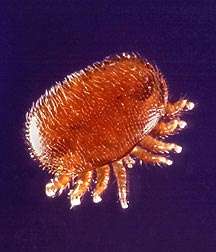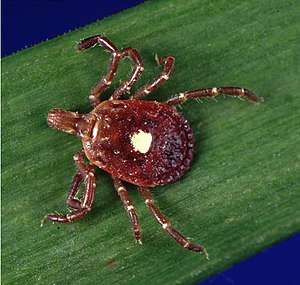Varroa
| Varroa | |
|---|---|
 | |
| Varroa destructor | |
| Scientific classification | |
| Kingdom: | Animalia |
| Phylum: | Arthropoda |
| Class: | Arachnida |
| Subclass: | Acari |
| Order: | Mesostigmata |
| Superfamily: | Dermanyssoidea |
| Family: | Varroidae Delfinado & Baker, 1974[1] |
| Genus: | Varroa |
| Species | |
|
Varroa destructor | |
Varroa is a genus of parasitic mites associated with honey bees, placed in its own family, Varroidae.[4] The genus was named for Marcus Terentius Varro, a Roman scholar and beekeeper. The condition of a honeybee colony being infested with Varroa mites is called varroosis (also, incorrectly, varroatosis).
Varroa mites are recognised as the biggest pest to honeybees worldwide due to their ability to transmit diseases such as deformed wing virus (or dwv) to larval or pupating bees, resulting in death or severe deformity of the pupae.
History and behavior
Varroa mites feed off the bodily fluids of adult, pupal, and larval honey bees, and may carry viruses that are particularly damaging to the bees (e.g., deformed wings, and IAPV), and accordingly they have been implicated in colony collapse disorder. Research has indicated that alone, neither Varroa mites nor deformed wing virus are particularly deadly, yet together they can pose an incredible risk to colonies.[5][6]
Varroa mites were first discovered in Java about 1904,[7] but are now present in all honey bee populations except Australia, Isle of Man and northern parts of Norway. They were discovered in the United States in 1987, in New Zealand in 2000,[8] and in the United Kingdom in 1992 (Devon).
Bee-breeding efforts to develop resistance against Varroa are ongoing. The USDA has developed a line of bees which uses Varroa-sensitive hygiene to remove reproductive mites. This line is now being distributed to beekeepers to be used as part of their integrated pest management programs.
Species
The genus Varroa contains these species:[4]
- Varroa destructor Anderson & Trueman, 2000[7] is a virulent parasite that infests its natural host, Apis cerana (Asian honey bees), on mainland Asia and also Apis mellifera (western honey bee) worldwide.
- Varroa jacobsoni Oudemans, 1904[2][3] is a relatively benign parasite of Apis cerana.
- Varroa rindereri de Guzman & Delfinado-Baker, 1996[9]
- Varroa sinhai (Delfinado & Baker, 1974)[1]
- Varroa wongsirii (Lekprayoon & Tangkanasing, 1991)[10]
Resistance
Some honey bees strains have become resistant to Varroa.[11][12] These strains have developed Varroa-sensitive hygiene behavior and can detect and remove Varroa in brood.
References
- 1 2 Delfinado, M. D.; Baker, E. W. (1974). "Varroidae, A New Family of Mites on Honey Bees (Mesostigmata: Acarina)". Journal of the Washington Academy of Sciences. 64 (1): 4–10. JSTOR 24535743.
- 1 2 Oudemans, A. C. (1904). "On a New Genus and Species of Parasitic Acari". Notes from the Leyden Museum. 24 (4): 216–222.
- 1 2 Oudemans, A. C. (1904). "Acarologische Aanteekeningen XII". Entomologische berichten. 1 (18): 160–164.
- 1 2 Joel Hallan. "Varroidae Delfinado & Baker, 1974". Texas A&M University. Retrieved June 13, 2010.
- ↑ "Mites, Viruses Sicken Bee Hives - Colony Collapse Disorder - Hawaiian Honeybee Infection". LiveScience.com.
- ↑ "Bees Wiped Out by Cascade of Deadly Events". LiveScience.com.
- 1 2 D. L. Anderson & J. W. H. Trueman (2000). "Varroa jacobsoni (Acari: Varroidae) is more than one species". Experimental and Applied Acarology. 24 (3): 165–189. doi:10.1023/A:1006456720416. PMID 11108385.
- ↑ Zhi-Qian Zhang (2000). "Notes on Varroa destructor (Acari: Varroidae) parasitic on honeybees in New Zealand" (PDF). Systematic & Applied Acarology. Special Publications. 5: 9–14.
- ↑ de Guzman, L. I.; Delfinado-Baker, M. (1996). "A new species of Varroa (Acari: Varroidae) associated with Apis koschevnikovi (Apidae: Hymenoptera) in Borneo". International Journal of Acarology. 22 (1): 23–27. doi:10.1080/01647959608684077.
- ↑ Lekprayoon, C.; Tangkanasing, P. (1991). "Euvarroa wongsirii, a new species of bee mite from Thailand". International Journal of Acarology. 17 (4): 255–258. doi:10.1080/01647959108683915.
- ↑ "Arista Bee Research - Foundation for breeding varroa resistant honey bees". aristabeeresearch.org.
- ↑ "USDA ARS Online Magazine Vol. 47, No. 8". usda.gov.
